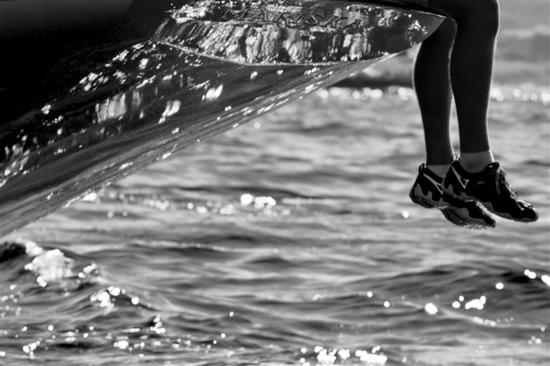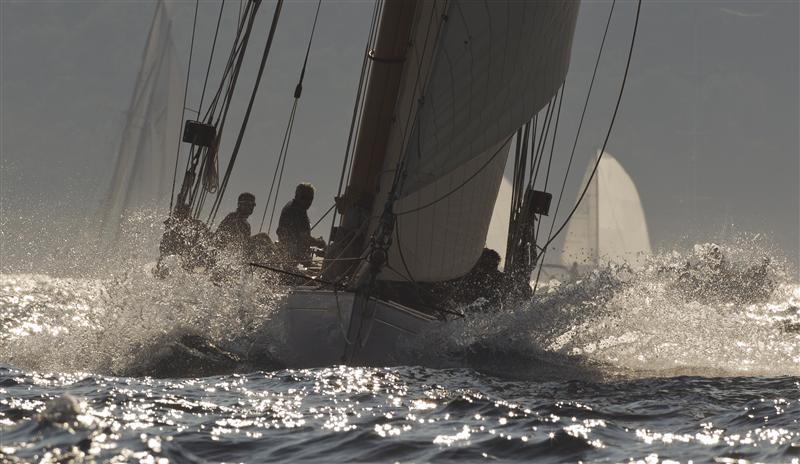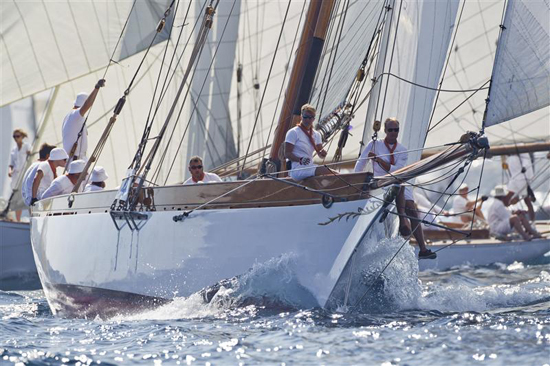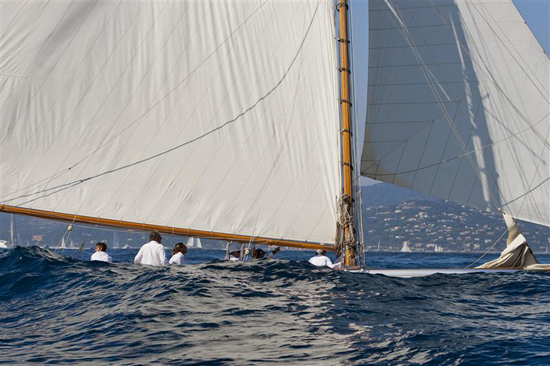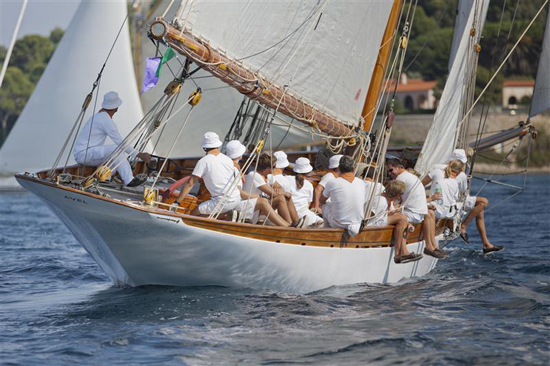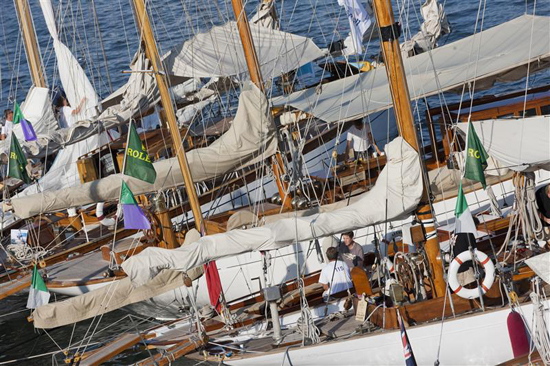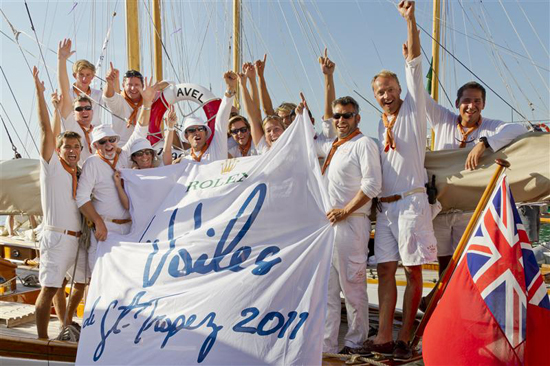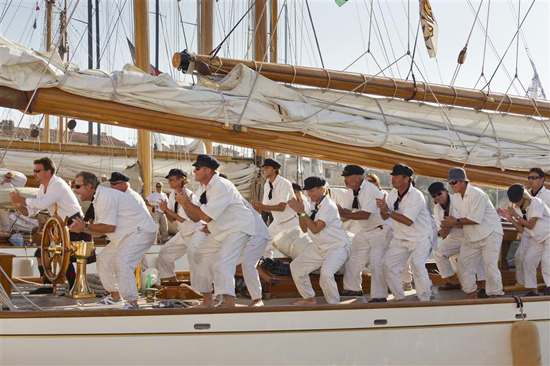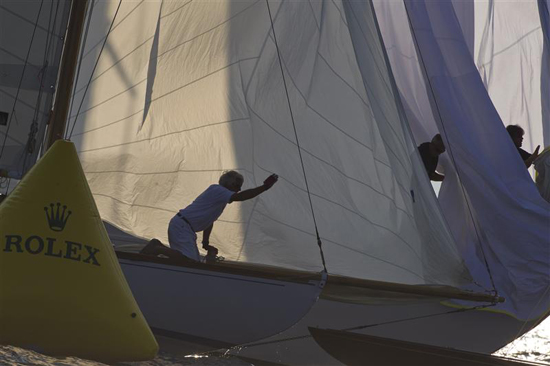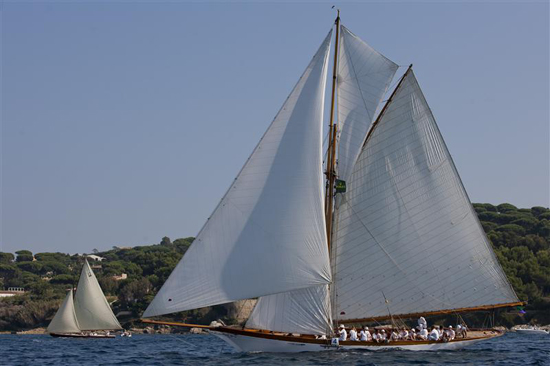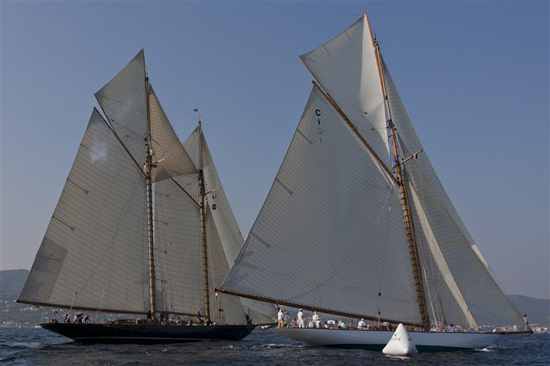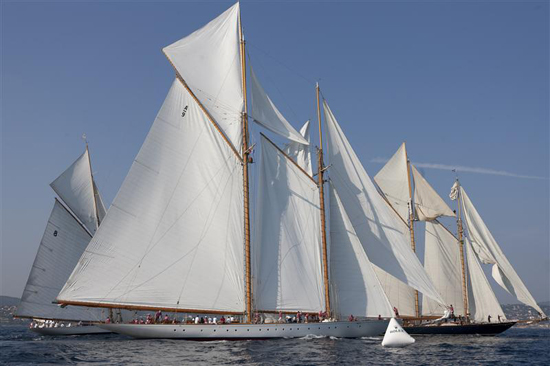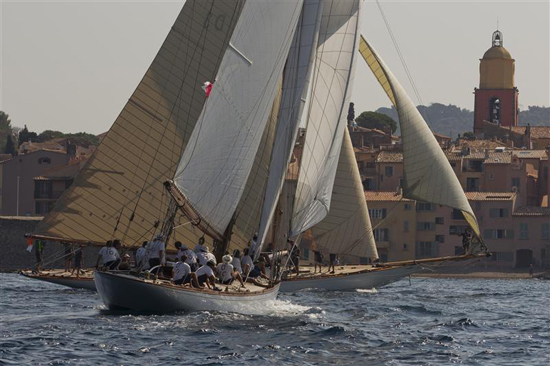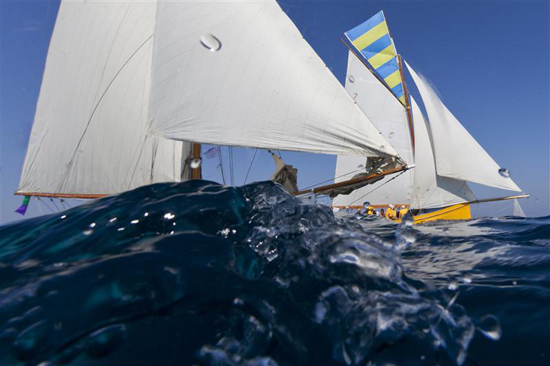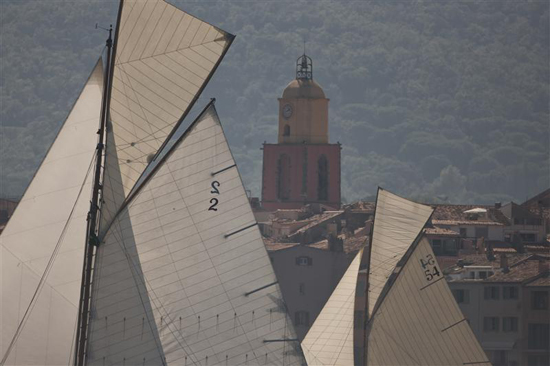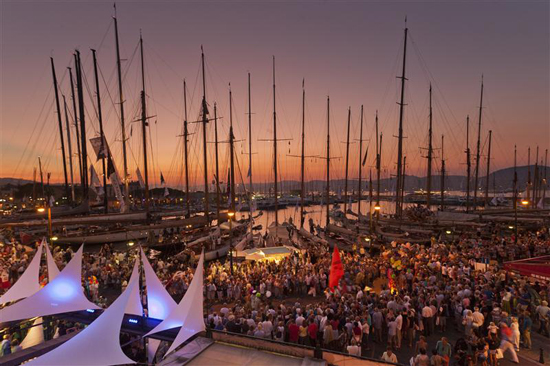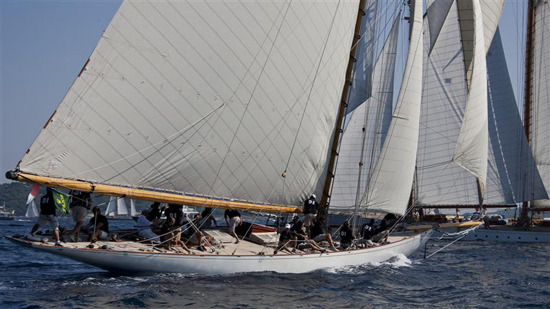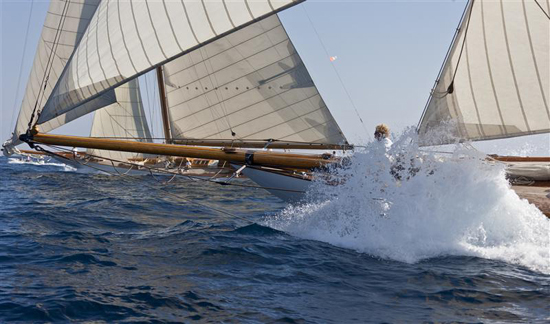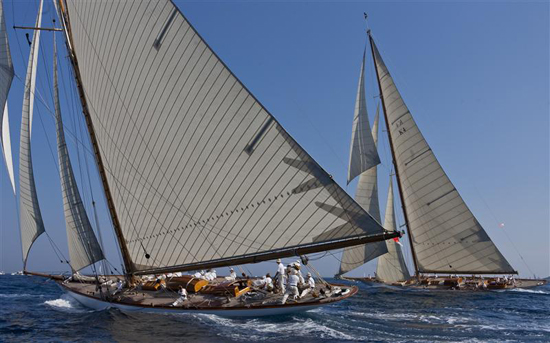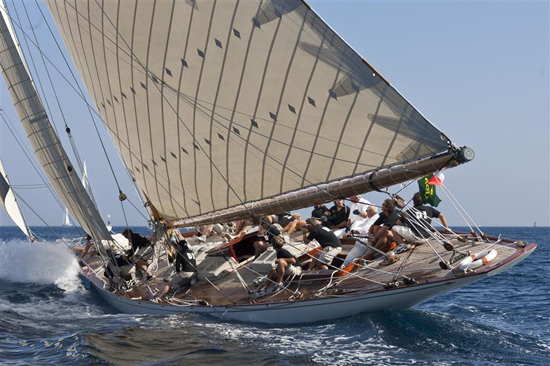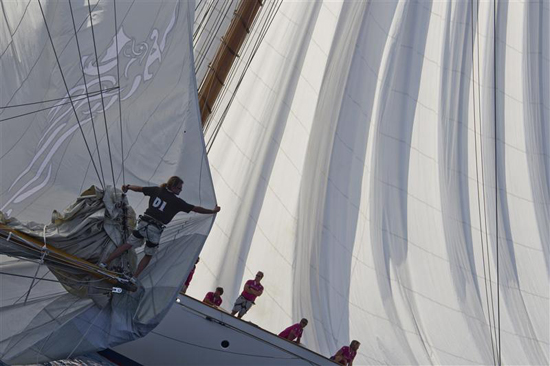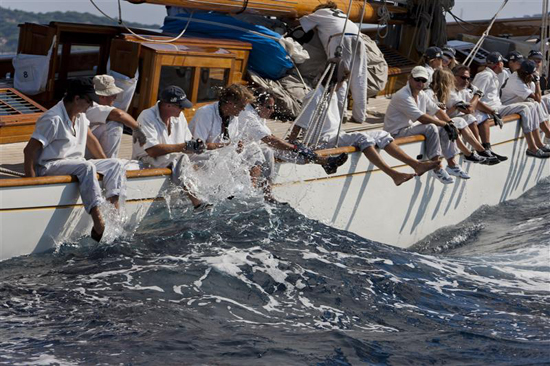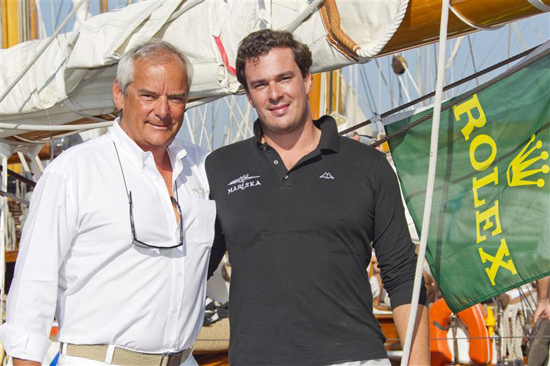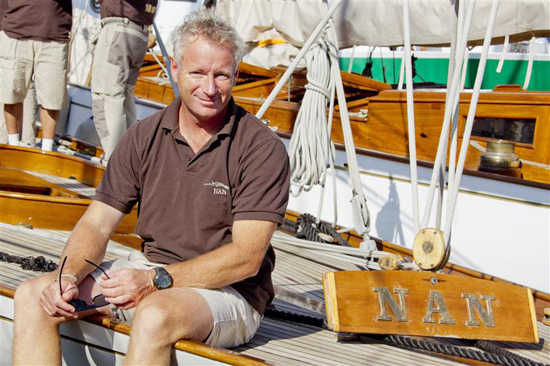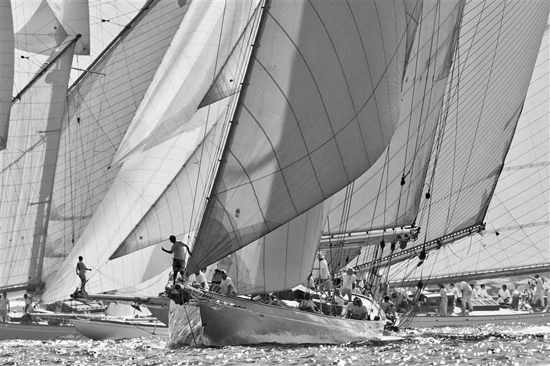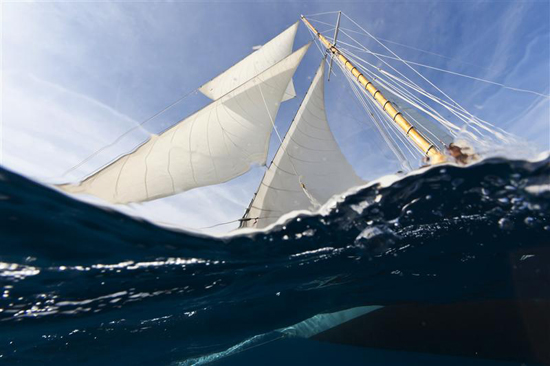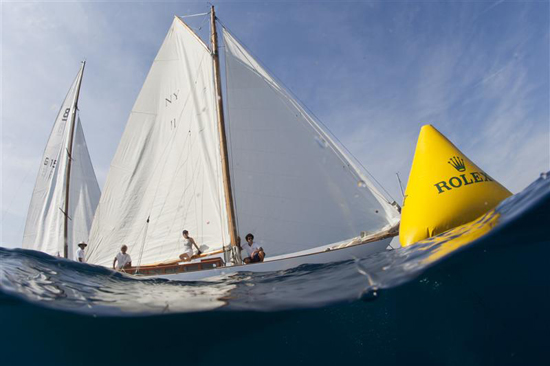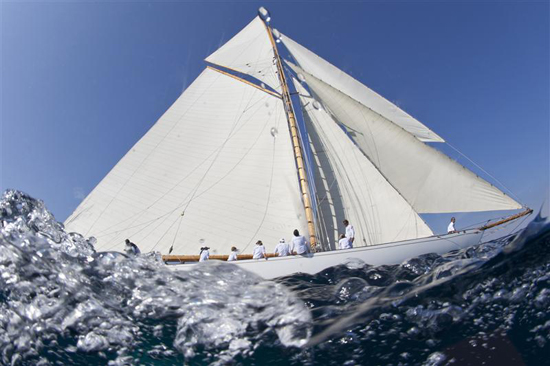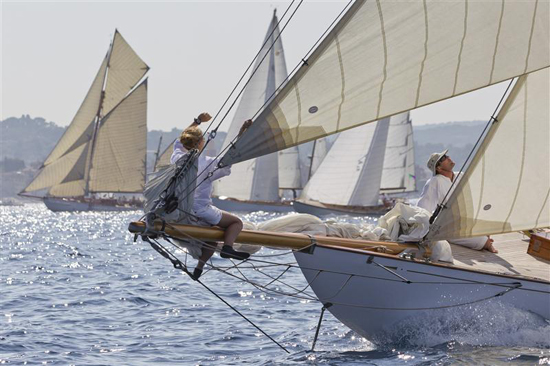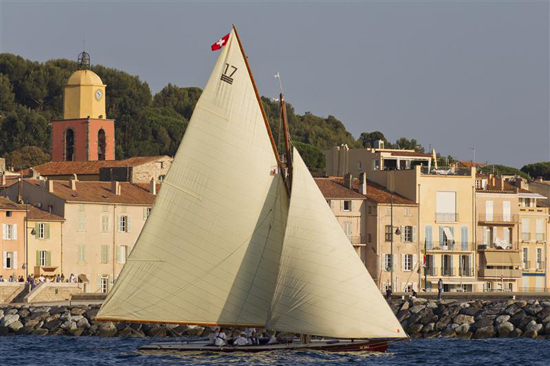 |
||||||
|
|
|
|
Die "Voiles de Saint-Tropez" begannen am 27.9. für die klassischen Yachten. Was vor über 25 Jahren als "La Nioulargue" begann, zieht heute Yachten und Klassiker- Enthusiasten aus der ganzen Welt an. Die Regatten in der Bucht von Saint-Tropez begeistern...
MUDBANK TO THE PODIUM Another sultry day on the French Riviera as racing concluded for the week at Les Voiles de Saint-Tropez. For the boats at this year’s edition, no amount of wind dances or prayers could conjure up enough breeze for a final day of racing. For the Tradition fleet, with a bit of déjà vu for the week, after a few hours of the fleet struggling to get upwind, the decision was made to abandon racing for the day. All standings as of Friday would remain intact. For the Rolex Trophy group, three races would be counted for the week. With a scoreline of 1-1-1, the 75-foot gaff cutter Avel, won their class (Epoque Aurique), as well as the Rolex Trophy, which will be awarded – with a Rolex timepiece – at tomorrow’s prizegiving at La Citadelle. The Rolex Trophy is awarded to the low point winner from the Tradition division boats that are more than 16 metres (length on deck). There were 51 boats eligible in this division, spread over eight classes in the fleet. Avel raced in the 13-boat Epoque Aurique B class with other boats of near the same vintage including Nan of Fife and Veronique. Despite her 100+ year age and gaff sail plan, Avel’s wine-glass shaped underbody is well-suited for the light air that was predominant this week. The boat, originally built in 1896, is owned and raced by Allegra and Alessandra Gucci. The Italian sisters have sailed onboard since it was re-launched in 1996, following a complete restoration. Allegra was at the helm of Avel when the boat finished first in the feeder race last week from Cannes to St Tropez. For Les Voiles, skipper Chris Austin was helming, while Allegra was on the bow, and Alessandra on the mainsail. Clearly delighted with the win, Allegra said, “It was very difficult, with such light winds, but we have an excellent crew. Avel likes the conditions, and we went in the right direction!” Austin added, “Tactically we were very good. We’re really happy for the week. We had a bad start today, but we came up through our class and got to La Mouette buoy, and were first in our class at that stage – between the rest of our class and the finish line. Avel was discovered in a mudbank in West Mersea, on the southeast coast of England – an area where many other vintage yachts have been found. At the time in 1991, the boat was being used as a houseboat. Austin describes the boat as it was found, “She had sat there since between the wars. We found her, dug her out and restored her (from 1992-4). She was really one of the very few yachts that were found in a repairable condition. I mean she’s so original – the interior is 85%, the hull is 85% original, so it was really good to find her…she’s a gem, a rarity! Second to Avel for the Rolex Trophy wasMariska, which won her class (15 Metre) with a score of 2-1-1. Built in 1908 and owned by Christian Niels, it is one of three 15 Metre class yachts racing at Les Voiles. Mariska underwent a full restoration, was relaunched in 2009 and has been having a successful run ever since. Third placed was Rowdy, co-owned by Graham Walker and Neil Barham. The New York 40 class sloop won the Rolex Trophy in 2008 & 2009. The season-ending Les Voiles de Saint-Tropez is one of the bigger regattas in the Mediterranean – and certainly one of the most diverse in terms of type of fleet. For the modern fleet, the boats are rated under IRC, while the tradition class follows the CIM (Comité International de la Méditerranée) rule, and as the regatta is based in France, is run under the auspices of L'Association Française des Yachtsde Tradition. To determine which boats race in what division, the duty falls to Roger Gibert and Renaud Godard, CIM measurers. For Les Voiles, the fleet is divided as to age and material of hull construction. So, the Tradition class includes all yachts launched prior to December 31, 1975, and built of wood or metal. All others from 1976 forward, including all yachts built of fiberglass, carbon fibre or other materials, race in the Modern division. Then under the Tradition division, there are further distinctions as to the age of yacht. All boats launched from 1950 – 1975, again only in wood/metal, are considered “classique”; those launched prior to 1950 are considered “époque”. The 51 boats that competed in the Rolex Trophywere spread across eight classes: Grande Epoque, 15 Metre, Epoque Aurique (A+B), Epoque Marconi (A+C+D), and Classique Marconi B. The Rolex Trophy was first awarded in 2006, past winners include: 2010 – Ikra, 12-metre. Originally built as Kurrewa V, a trial horse for the Royal Thames YC for the 1964 America’s Cup. Later owned by Baron Bich, who sold it in 1977, after which it was converted for racing/cruising in the Mediterranean. 2008 & 2009 – Rowdy, Herreshoff-designed New York 40 class. Commissioned by the New York Yacht Club and built in 1916, this design is 40 feet on the waterline (approx 65 ft LOA).Grand 2007 – Agneta, 25-metre yawl, built in 1951.Agneta’s beautiful varnished mahogany hull and tanbark sails are unmistakable on the water. 2006 – So Fong, 25 metre Marconi-rigged schooner. Designed by the renowned naval architecture firm, Sparkman & Stephens and built in Hong Kong in 1937. The prizegiving for Les Voiles de Saint-Tropez will take place tomorrow, Sunday 3 October at 11am at La Citadelle, the 16th century fortress overlooking the Golfe de Saint-Tropez.
ROLEX TROPHY STARTS TO UNFOLD Les Voiles de Saint-Tropez is notable for the diverse fleet of boats that turn up each September on the Cote d’Azur for a week of racing. Nearly half the fleet of 300 modern and classic boats is sailing in the Tradition/Classic classes. The Tradition fleet is made up of 130 boats spread across several classes including: the 15 Meter class, Grand Epoque, Epoque Marconi, Epoque Aurique, Classique Marconi, and the diminutive Tofinou, the modern French-built day-sailer. For the Tradition class, boats must be built prior to 1975, though most of them are quite a bit older. Loosely translated the époque boats are the older, vintage boats, while the “classique” are the based on classic designs. All manner of sail plans and rig designs are seen across the fleet represented by “aurique” which is gaff-rigged, “Marconi” which denotes a Bermuda-rig, with a triangular mainsail and a jib. Since 2006, a special award – The Rolex Trophy – has been presented for traditional boats 16 metres and longer on deck. This year there are 51 yachts in this group, and the Trophy is awarded to the overall low point scorer. The winning boat will receive the Rolex Trophy and a Rolex timepiece. The 2010 winner, Yves-Marie Morault, on the 12-metre Ikra, is back with his crew, including tactician former America’s Cup sailor Sébastien Destremau, to defend the title. Today’s racing was postponed for several hours as competitors waited for wind – a familiar circumstance this week as a high pressure over southern Europe has produced unusually benign sailing conditions, not typical for a time of year that often sees the mistral. The modern fleet finally got their first race – for the week, while the tradition fleet also got a late start and again a shortened course, as once clear of the gulf the breeze died off. Many boats in both modern and traditional classes retired, when faced with not making the time limit. Results were pending at press time. Leading overall for the Rolex Trophy after two days of racing (through Thursday) – theoretically the halfway mark in the regatta – were Avel and the two-time prior Rolex Trophy winner, Rowdy. Avel, named after a wind found in Brittany, is striking for her clipper bow and varnished sheerstrake. The gaff cutter measures 57 feet on deck, and with her long, graceful overhangs, stretches to 75 feet overall. Truly from another era, she was originally built in 1896, commissioned by Frenchman Rene Calame to a design by Charles Nicholson, and built at the Camper & Nicholson yard in Gosport, UK. In 1990, she was discovered in a river in southeast England, neglected and in dire need of attention. An Italian purchased Avel and brought her to Harry Spencer’s boatyard in Cowes for, what was, a four-year restoration. In 2010, Avel was awarded the Prix du Yacht Tradition in Saint-Tropez. The boats standing at the top of the Rolex Trophy leaderboard showcase the range of design and periods of classic yachts on display here. Rowdy is a New York 40 class, designed by Nathanael G. Herreshoff and built at the Herreshoff boatyard in Bristol, Rhode Island. She was built in 1916, one of twelve of these one-designs ordered by the New York Yacht Club. Standing tied for third is the 15 Metre class, Mariska and the 23 Metre class, Cambria both Fife-designed and built by Fife in Fairlie, Scotland. Mariska is one of four 15M class boats restored and racing again; three of them are here in Saint-Tropez. Tied in fourth place are several boats including White Dolphin and Stormy Weather. White Dolphin was built in 1967 for Sergio Rossi, then a Director of Fiat. The teak and mahogany 73-foot Bermuda ketch was the last sailboat built by Vincenzo Beltrami, at the prestigious shipyard Cantiere San Germani. White Dolphin has sailed in many of the classic yacht races in the Mediterranean, but it is also extremely comfortable and well suited for the extended cruising that she was designed to enjoy. Stormy Weather is a 54-foot Sparkman & Stephens-designed yawl built in 1934, at the Nevins yard in New York. Launched five years after the famous Dorade, which was the first design from the young Olin Stephens’ hand, Stormy Weather had a long and successful yacht-racing career capped with wins early on in the Transatlantic Race, the Fastnet Race, and the Bermuda Race. At the time of her launching and subsequent successes, she impressed sailors including noted English boat designer, Uffa Fox, whose comments then could echo true today, “Stormy Weather is one of Olin Stephen’s favourite designs and her lines show her to be beamy and powerful, yet very easily driven, and therefore fast. She is exactly the type of vessel favoured by the new American rule for ocean racing, a type that should gladden the hearts of those who go down to the sea in such small ships.” Les Voiles de Saint-Tropez is a treasure trove of yachts, some more than one hundred years old, others from more recent eras, many impeccably restored, while others are waiting to be -- but all appreciated and enjoyed by the sailors and enthusiasts who gather in the old port to keep the spirit of the past thirty years alive. Saturday is the final day of racing for all of Les Voiles fleet. First warning signal is 1100 for the Moderns, 1200 for Traditional. On Sunday, the final Prize-giving ceremony will be held at La Citadelle, the 16th century fortress overlooking the Golfe de Saint-Tropez.
S & S: SPEED UNDER SAIL Midweek in St Tropez is traditionally a layday for the modern fleet, and sort of a busman’s holiday for the classic fleet. Today is Challenge Day with one ‘featured’ race of the day, and a host of other informal challenges were struck for match races between competitors, solely for bragging rights. This year, the Club 55 Cup match was between the 140-foot 19 Metre Class, Mariquita and the 128-foot gaff schooner, Altair – both designed by William Fife III. Following tradition, the Club 55 Cup race course had a start off St Tropez, from the Tour du Portalet, around La Nioulargue buoy to the finish line off Club 55 on the beach in Pampelonne. After finishing, the crews transfer to the beachside restaurant for lunch, with the losing skipper hosting the drinks. Racing along with the pair from the “big boat” fleet was the 12metre Ikra, one of the two competitors from the original match race that started La Nioulargue, the predecessor to Les Voiles de Saint-Tropez back in the fall of 1981. The other boat was the Swan 44, Pride, owned by American Dick Jayson. The boat and enthusiastic skipper competed right through 1995, and even returned for the 20th reunion in 2001. Eventually, the family sold the boat about six years ago, and Jayson is now in his late 80s. Pride was scheduled to be in St Tropez for the 30th anniversary from its new homeport in Sicily, Italy, but was cancelled due to weather. Fortunately, family reinforcements were on hand: son Bill Jayson and his wife, Anne, were in St Tropez to represent the elder Jayson. As were Patrick Almere and Sebastian Le Ber, President of the nearby Yacht Club de Porquerolles, and both local sailors who were part of the original Pride crew. Bill Jayson, reflecting on his father’s participation said, “Age took its measure and he really was not able to sail competitively anymore, so he stopped. But we have great memories of sailing here with my dad, and the way he made friends with the people here. Patrice de Colmont (from Club 55) was really the person that got things going after the first race. They thought ‘this was so much fun, let’s invite some more boats… and then we’ll invite some more boats’, and it just keep getting bigger and bigger. It was certainly fun to tag along with my father all these years.” For other boats, both modern and traditional, about a dozen individual challenges were made, with the planned course 6.5 nautical miles. One pair, which showcased the famous American design firm, Sparkman & Stephens, was the match between the yawl-rigs Skylark, 53 feet, and Argyll, 57 feet. Both are great examples of Olin Stephens impeccable eye: Skylark (1937), is owned by Tara Getty, and Argyll (1948) by the Welsh comedian and actor, Griff Rhys Jones. This years’ Les Voiles marks the debut of Skylark in Mediterranean waters. The boat only arrived in June, having been shipped from Newport, Rhode Island, where it spent the last eight years going through an on again/off again refit. Fortunately, its’ pedigree – a near sister-ship to the well-known Stormy Weather – and condition warranted attention and ultimately an American owner invested the resources to ensure a thorough refit by classic yacht restoration specialists, LMI Newport and East Passage Boatwrights. Getty owns the impeccable 100-foot motor yacht, Blue Bird, a classic beauty, and he clearly has an eye and appreciation for period yachts. Blue Bird was built in 1938 for Sir Malcolm Campbell, an English racing motorist who held the world speed record on land and on water during the 1920s and 1930s using vehicles called Blue Bird. For the match against Argyll, Getty put up the Blue Bird Cup, a striking sterling silver trophy that was awarded to Campbell in 1938 for setting a land speed record. No stranger to Les Voiles de Saint-Tropez, Getty raced every year on boats he chartered with friends. Meanwhile, he kept looking for a suitable sailing yacht, one from an era similar to Blue Bird. He searched for two to three years, almost buying another boat that wasn’t quite right, post-war versus pre-war. Getty said, “Sometime last summer I saw Stormy Weather and I thought, ‘Okay, now I know what I’m looking for’.” Having only taken delivery of Skylark in June, Getty and family spent July and August cruising in Corsica with Blue Bird and enjoying day sailing on his new S&S yawl. He said, “For me, she’s a perfect size, because if she’s too small, I can’t really have crew living on her comfortably, and if she’s too big she becomes too much of a hassle to sail – like the big gaffers who needs lots of crew. I want minimum crew, so if we go away you only need one person onboard and that’s it. “So it’s very difficult to find the right boat for that if you’re looking at vintage boats, but quite difficult to tick all the boxes. So far we’ve been quite lucky, the test will be to see how well she’ll race, because as a cruising boat, she’s worked wonderfully – every day we’ve gone out for a couple of hours and have had some lovely, lovely sails.” Given that this is Skylark’s first regatta this year, the results seem less important than the joy in finding such a gem, Getty adds, “We have a really strong crew and none of us are really professionals: friends, and friends of friends, and my family. I don’t want to do a full professional thing, it’s not what we’re gunning for. This is our first event this year and it’s wonderful to finally be doing it on your own boat, even though Skylark is not very big compared to some of the boats we’ve been sailing on. This is her first time in Europe, so it must be causing a bit of interest because it’s another Sparkman & Stephens come over (from the US), very similar to Stormy Weather, Dorade, and Sonny…the famous ones. She’s not been seen in Europe.” The race between Skylark and Argyll was closely fought in the fickle breeze. While Skylark led most of the way around the course, Rhys Jones and his crew on Argyll picked the shifts well, managing to sail into more breeze on the last leg and finished in front of Argyll to win the Blue Bird Cup. New this year was the Centenary Trophy, a race for traditional boats over one hundred years old (built prior to 29 October 1911), hosted by the Gstaad Yacht Club. With the very light southeasterly breeze over the gulf of St Tropez, the course was eventually shortened, with 15 boats managing to finish. Placing first overall was the 44-foot Bonafide, a “5 tonner” class originally built in 1899, then rebuilt and relaunched in 2003. At Les Voiles de Saint-Tropez, the Rolex Trophy is a competition within the tradition/classic classes for all boats 16 metres and longer on deck. The winning boat will receive the Rolex Trophy and a Rolex timepiece. First awarded in 2006, this year over 50 boats are eligible. The winner from 2010, Yves-Marie Morault, on the 12-metre Ikra, is back to defend. Racing continues Friday and Saturday for both Traditional and Modern classes. First warning signal is 1100 for the Moderns, 1200 for Traditional. On Sunday the final Prizgiving ceremony will be held at La Citadelle, the 16th century fortress overlooking the Golfe de Saint-Tropez.
SUMMER CONDITIONS PREVAIL It’s equally inspiring, whether you experience the fleet on the water – the Golfe de Saint Tropez chockablock with gaff schooners, Marconi cutters, sloops, ketches, and yawls for the race start – or ashore, where up to fifty yachts moor Med-style, stern-to the quay in the old port. At night, the yachts are lined up varnished caprail to caprail, with spreader and deck lights illuminating the wooden spars that tower above -- presenting an enchanting setting for those strolling the old port, and spilling out of the popular Hotel Sube’s and other adjoining restaurants and bars. For all traditional classes, it was a trying day on the water with light and variable breeze. All classes started and then struggled to sail up the coast – the wind clocking to the south and up and down in velocity, causing the race committee to shorten the course. One need not be a yachting historian, but just have an appreciative eye for beauty and design to notice the myriad details on the yachts on the quay: the exquisite and highly polished bronze hardware, efficient ropework, and perfect brightwork. One of the most revered designers, whose boats grace St Tropez, is the Scotsman William Fife III (1857 – 1944), the third generation of a boatbuilding family. His first successful design was the Dragon class in the late 1800s, and by the turn of the century he had already designed the first of two America’s Cup challengers – Shamrock I & II – for the tea magnate, Sir Thomas Lipton. In the early 1900s, he turned his impeccable eye to metre boats, notably the 15m and 19m classes. This year there is a bumper fleet of Fifes including: the 23 metre class, Cambria; the gaff schooner Altair; the gaff cutters Moonbeam III and IV; the 19 metre class Mariquita; the International 15 metre class Mariska, Tuiga, and The Lady Anne; Marconi cutter Hallowe’en, the gaff cutter Nan of Fife built in 1896. Given that there is only an estimated 50 or so of Fife’s designs still extant and racing, it’s impressive to consider this collection racing in St Tropez this week. Some Fife-designed yachts exist today though some sort of divine serendipity – certainly that played a part in the 115-year old Nan of Fife’s survival. Owner/skipper Philippe Menhinick has raced the 75-foot gaff cutter for the past ten years in St Tropez. Menhinick already owned a classic yacht and wasn’t really looking for one, he recalled, “I found Nan on the web, I was just looking on the net for nice boats and I saw this funny boat with an aluminum wheel, but all details on deck, so I wanted to see the boat in reality, so I went to see her in Cap d’Agde. Finally I discovered the name Nan and remembered my grandfather had a boat called Nan. I discovered that it was my grandfather’s yacht, he owned it between 1949 and 1952 – I had no idea at all, it was destiny! “My grandmother sold her engagement ring in 1951 to pay the expenses on the yacht, and in 1952 the boat was in really bad shape and my grandfather sold it to a Belgian guy from Ostend.” Forty-seven years later it was back in the family. Menhinick then spent 20 months restoring the yacht in a yard in Saint Malo, and finished in 2001, in time to race in the Americas Cup Jubilee in Cowes. Nan of Fife has been a regular at Les Voiles since then, as Menhinick said, “It’s my destiny for ten years, I’ve been looking after my yacht.” Serendipity indeed – Nan of Fife won their class in yesterday’s racing at Les Voiles. Another fine example of the Fife design is the International 15 Metre Class yachts. Fife designed eight of the 20 built, and of these three are racing this week (a fourth, the recently re-launched Hispania, withdrew shortly before the regatta started). Mariska, owned by Christian Niels, who races along with his son, Axel, onboard. Niels bought the boat in late 2006 and it underwent a meticulous two-and-a-half year full restoration, with up to 40 people full-time on the project in La Ciotat, France. The boat had been customized, with five metres sawn off the aft end, and no existing mast. The boat sails with a base crew of four, but for racing the numbers grow to 20 or so, many of them friends. For Axel Niels and his family, St Tropez is a special place. He said, “We’ve been coming here for generations, it’s a family place for us. There are a lot of friends who we’ve known for decades and we’re very happy to invite them on the boat for a race at Les Voiles. We’re also sporting the colours of La Société Nautique de Saint-Tropez, so theoretically it’s our home base.” This is Mariska’s second season and the boat and crew are busy enough just racing in the Mediterranean classic circuit, which they won overall in their division last year. This year, Mariska has won already in Antibes and in Monaco, which was noteworthy as they bested Tuiga, a sister-ship from the Yacht Club de Monaco. Axel Niels said, “It’s been the main competition for the past two years. It’s the first time the four (15m class) boats were reunited again. Now we have St Tropez, so we’ll see how it goes, but we’re real happy to be here. “It’s fantastic to see these boats racing together, they are the four left in the world out of the series of twenty. As they were named in Monaco, it is the “belle classe” – they really were the noble racing boats, it’s fantastic to see them together again.” The Rolex Trophy is a competition within the Tradition division for all boats over 16 metres on deck. The winning boat receives the Rolex Trophy and a Rolex timepiece. First awarded in 2006, this year over 50 boats are eligible for the Trophy. The winner from 2010, Yves-Marie Morault on the 12-metre Ikra, is back to defend. Tomorrow at Les Voiles de Saint-Tropez is the traditional Club 55 Cup, a match race this year between Mariquita and Altair with start at 12noon. Following that is the Centenary Trophy for yachts over 100 years old. Finally are the other Challenge Day match races set up between yachts, the list to be finalized tomorrow. Racing continues Friday for both Traditional and Modern classes. First warning signal is 1100 for the Moderns, 1200 for Traditional.
Aus dem Tagesbericht vom 27.9.: There could not be a more impressive fleet of classic boats then the more than 100 racing this week at Les Voiles de Saint-Tropez. It's an armada that showcases designers from the golden ages of yachting history: among them, Herreshoff, Fife, Sparkman & Stephens, Rhodes, Mylne, and Alden. The summer-like conditions that prevailed on the Golfe of St Tropez outside of the old port featured plenty of blue sky, an unseasonably hot sun, and light breeze. Racing was schedule for 12noon, and after an hour’s postponement, Les Voiles de Saint-Tropez race committee managed to find enough wind in the starting area to send the fleet on a short nine-nautical mile coastal race, once the easterly breeze filled in to about five knots. It was enough to get nine classes off the line in five starts – first the smaller gaff-rigged and Marconi classes and through to the “grand époque” big boats with stunners such as the 167-foot (51m) overall Herreshoff schooner Elena, the 19-metre class (110 feet overall) Mariquita, the Fife-designed gaff cutter 115-footer Moonbeam IV, and the 23-metre class, Cambria.
Even given the nearly half mile starting line for the twelve big boats, Mariquita, Tuiga, and Moonbeam were in a group that proved intent on the favoured committee boat end. Alone towards the pin end was Cambria, which found more pressure on the northern side of the gulf. Elena was safely just behind the first starters, but her towering sail plan made the most of the challenging conditions and allowed her to quickly gain on the others. Most boats, having left the gulf and cleared the Porte Seiche mark, found the breeze clocking towards the south which allowed a mix of running sails to be set: spinnakers, fishermen, topsails. Further along the coast, the wind went painfully light, and the fleet compressed around the leeward mark off the town of Issambres. From there it was a beat upwind until they could lay the mark of Porte Seiche and then ease sheets for a reach towards the finish in a slighter fresher breeze. They were the lucky ones – for several of the bigger boat classes, the course was shortened and a finish line set off Porte Seiche. Given the weight differential with this range of classics, certain boats fared better in the light conditions: two-time Rolex Trophy winner (2008 & 2009) NY 40 Rowdy for one. Skipper Graham Walker knows his way around the race course here. This time around, Walker has turned the tiller over to his new co-owner Nick Barham. An Englishman from Monaco, who has extensive experience racing in the competitive Sydney 38 one-design class, Barham is clearly thrilled to be competing in St Tropez, “It was a very difficult start, very tight on the start line, but we managed to get some clean air. Got up to first mark and slipped away with the wind, fantastic…perfect conditions for us, and a wonderful sail. After the leeward mark, we hung up to windward until we had about twenty degrees off the mark we had to come inside. Then we picked up a whole new breeze coming down towards the finish. The crew performed superbly.” Rowdy will again be a force to be reckoned at Les Voiles this week as the 1916 Herreshoff sloop is coming off a successful season, with wins at Antibes, Porto Rotondo and Monaco. The crew is pretty much the same as prior years with some family members having come on as well, though Barham said “we’re not de-professionalizing it, but making it a little more social than before.” The Rolex Trophy is a competition within the Tradition division for all boats over 16 metres on deck. The winning boat receives the Rolex Trophy and a Rolex timepiece. First awarded in 2006, this year over 50 boats are eligible for the Trophy. Defending winner from 2010 is Yves-Marie Morault’s 12-metre Ikra. Racing continues tomorrow (28.9.) for both Traditional and Modern classes. First warning signal is 1100 for the Moderns, 1200 for Traditional. Les Voiles de Saint-Tropez 2011 Event Programme Sunday, 25 September: Welcome for Modern yachts
|
|||
|
|
||||||
